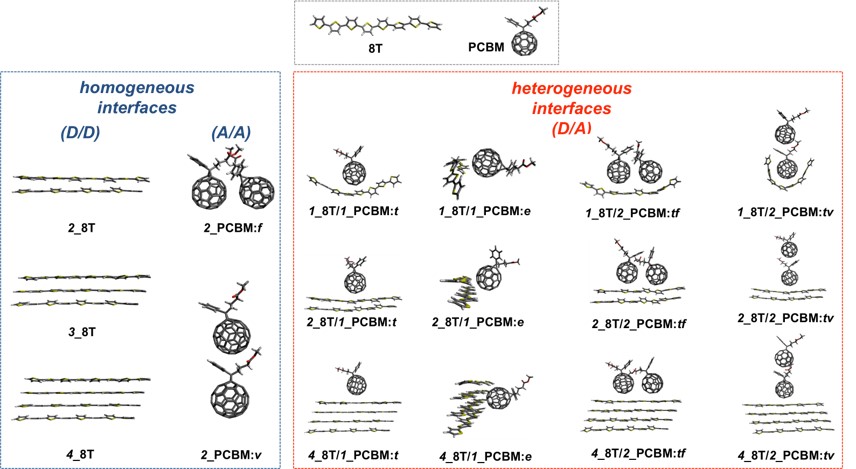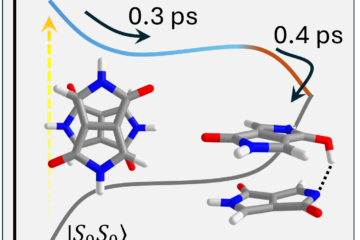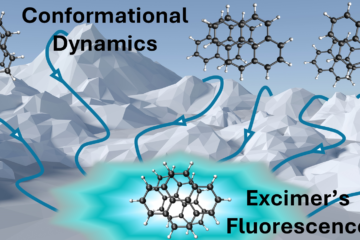Charge separation follows different photophysics in different donor/acceptor arrangements.
In brief:
- The dependence of the electronic structure on the geometric configuration of an organic heterojunction was determined using first-principles quantum chemistry.
- D/A junctions as large as four 8-thiophene oligomers plus two PCBMs were studied.
- On-top orientations favor hot CT processes, while on-edge orientations allow hot and cold CT processes.
The development of organic photovoltaics (OPVs) has been the grail of renewable energy research. Devices based on such technology would, at the same time, reduce carbon footprint and enable multiple applications based on inexpensive, light, and plastic organic substances.
The problem to tap into this potential has been to control charge separation, the key step to produce electric current out of a photoexcited system. In one of the most common architectures for OPVs, devices are based on donor/acceptor blend interfaces. As result of the photoexcitation, donor molecules transfer an electron to the acceptors, initiating the charge separation. However, recombination is a major competing process; and most of the photoenergy can be just lost without yielding any current.
In a project led by Daniele Fazzi, from the Max-Planck-Institut für Kohlenforschung, we have investigated how the basic process of charge transfer at a typical organic interface happens [1]. Based on TDDFT calculations followed by automatic state classification of the electronic densities, we looked at how different types of states (localized, delocalized, charge-transfer) are ordered in different D/A arrangements. This study was systematically done for 8-thiophene (8T) oligomers (working as donors) interacting with PCBMs (working as acceptors). We have controlled the type of junctions (homogeneous x heterogeneous), the number of monomers (up to four 8T and two PCBMs), and the D/A orientation. The investigated systems are shown below.

The results revealed that:
- The absorption band doesn’t depend on the D/A orientation.
- The distribution of localized, delocalized, and CT states is strongly dependent on the number of monomers in the model.
- The distribution of CT states in the band is radically different depending on the D/A orientation.
This latter point is a remarkable feature of these D/A interfaces. When PCBMs were laid on the face of the 8T stack, the CT states were located at high-energy regions of the electronic band, near the absorbing states; they are hot CT states, which can be excited even at the Franck-Condon region.
Nevertheless, when PCBMs were laid on the edge of the 8T stack, the CT states spread throughout the band and some of them are even located at the bottom; thus, not only hot CT states but also cold CT states can be accessed after internal conversion.
This relationship between orientation and CT type is schematically illustrated below.
The different energetic distribution of CT states has major implications for the charge separation in terms of transfer rates. In fact, experimental research had already detected that D/A blend interfaces often present ambiguous processes, with simultaneous charge generation obtained from hot and cold optical-gap excitation, leading to instantaneous (CT transfer then, relax) and delayed (relax then, CT transfer) charge separation.
Now, we know why: in the D/A blend, both orientations are present; therefore, hot and cold CT states should be populated.
These results have been recently published in the Journal of Physical Chemistry Letters [1].
MB
Reference
[1]D. Fazzi, M. Barbatti, and W. Thiel, Hot and cold charge transfer mechanisms in organic photovoltaics: insights into the excited states of donor/acceptor interfaces; J. Phys. Chem. Letters. doi:10.1021/acs.jpclett.7b02144 (2017). doi: 10.1021/acs.jpclett.7b02144
- If you want to know more about the dynamics at homogeneous interfaces, check: Organic photovoltaics, make light-not-heat



